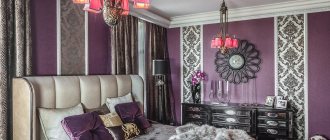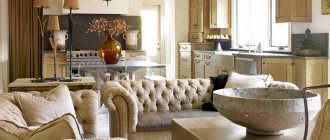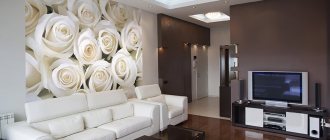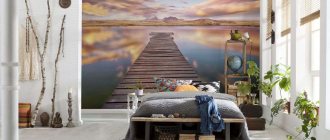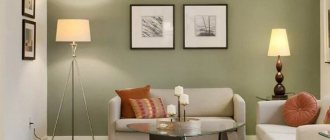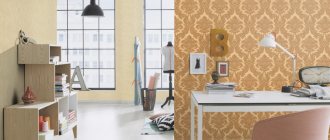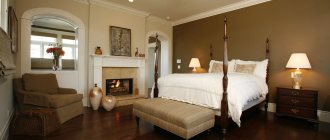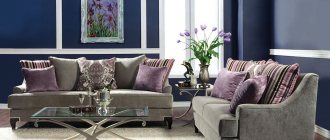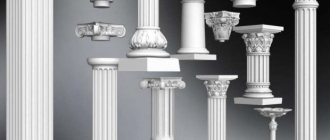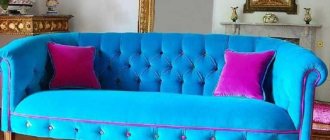Warm, pleasant, natural - all this is a surface that can be in an apartment if all finishing materials are used to lay cork in the interior. The material is ideal for creating a homely, warm environment. And we are not talking about those corks that are used to seal wine bottles, but about modern coatings that are used for decoration. Although the raw material for both is the same material.
Cork in the interior
Such well-known cork brands for finishing materials as Corckart, Corckstyle, Wicanders produce a wide range of products for interior decoration. Therefore, such material has long been no longer in short supply. They decorate floors and walls in apartments, houses and office spaces of various statuses.
From a stylistic point of view, cork in the interior is ideal for ethnic and country styles. Torn, heterogeneous and embossed surfaces are well emphasized by such style trends. Abstract shapes and bright cork designs are perfect for avant-garde and new styles. And aged coverings and wine corks in the interior are ideal for vintage, loft and chalet styles.
From an interior design point of view, the vast majority should not use one color or material. Therefore, it is advisable to dilute the cork with other materials. This rule mostly applies to walls. For example, using cork panels, you can create a zoning canvas on the walls near the TV area in the living room or at the head of the bed in the bedroom, as well as in the kitchen in the dining table area. This technique can be done in contrast or using materials that are similar in color but different in design.
How to glue?
What kind of glue?
Cork is quite a heavy material; in order for it to adhere securely to the wall, it is necessary to use a special adhesive. There is an adhesive specifically for cork; it takes into account all the nuances of the material. If it is not possible to purchase such glue, you can choose another composition intended for heavy types of coatings. You can also use acrylic-based glue.
Gluing technology
The technique of working with cork wallpaper is somewhat different from other types and has its own nuances.
- Before gluing it is necessary to prepare the surface. To do this, the wall is cleaned of the old finish, leveled and primed.
- Using a level or plumb line, a vertical line is marked, which will serve as a ruler for even gluing of the canvases. The line is marked from the middle of the wall and is equal to the width of the canvas.
- It is necessary to prepare the material. The wallpaper is cut into sheets of the required length, after which they need to be left to rest on the floor for a while.
- The glue is applied to the wall, a portion equal to the width of the canvas, after which the strip of wallpaper is pressed to the surface.
- The canvases are glued end-to-end starting from the horizontal line in both directions.
- If glue gets on the front side of the canvas, it should be allowed to dry and carefully removed.
Video
What are they made from?
Cork is the real bark of a tree. Which is removed from a special type of oak tree. They are called cork oaks. Here, like in most countries of the world, such trees do not grow. The ideal climatic conditions for them are in Portugal, and therefore they grow to a greater extent in this country. And it is not surprising that the majority of modern brands of cork finishing materials are made in this country.
Cork suitable for use takes 10 years to mature, so it is removed from each oak tree after this period. The “harvest” is taken starting from oak trees that have reached 20 years or more. For the production of floor coverings, cork layers or pressed agglomerate with a thickness of 3-6 mm are used. For wallpaper, the bark is crushed into a fine fraction and a composite is created from which wallpaper is subsequently produced.
Types of cork finishes
In most cases, finished coatings are supplied to stores in the form of rolls or slabs. As for the choice and types of products, today numerous supplier companies offer a fairly large number of diverse collections. Of course, in order to know exactly how to decorate your hallway, you need to understand at least at an initial level what types of this material are on the market. So, if we consider the main types, then there are two of them:
- Those that have a paper base.
- Not having such a paper backing.
So, let's talk about each of these types in a little more detail.
With paper base
In this case, the technology involves the use of two layers. One of them is a dense substrate - a paper base. A special decorative layer of cork veneer is glued on top of this paper base on the production line.
Helpful information! The fact that veneer is used as a decorative coating makes it possible to create truly attractive and unique combinations of patterns and colors on the surface of such cork wallpaper.
By the way, in addition to the paper base, non-woven backing is also widely used. It should be noted that the price of such materials will be slightly higher compared to other analogues, which can be classified more as an economy class.
Related article: Entrance hall in English style
Baseless
They are produced in factories where the so-called method is used. "hot pressing". This technology involves preliminary grinding of cork bark to the smallest particles, followed by exposure using high temperature treatment.
Oak bark, which is the main raw material for the production of this type of cork wallpaper, releases a certain amount of sticky properties when heated. As they cool, they harden, thus gluing the entire material together and making it a single whole.
Cork properties
Cork is such a pleasant and practical material that a huge number of things are made from it and are used in many areas of modern industry.
The structure of the cork is porous. The most interesting thing is that the pores are not empty, but filled with harmless gas. It seems that nature itself made sure that people began to use it to arrange their lives. After all, such a natural structure has a lot of useful properties.
The most obvious of them are thermal insulation and sound insulation.
In the first case, this is an ideal flooring material. The cork floor does not need heating, because it itself is warm. In addition, it does not let in the cold from outside. Therefore, cork underfloor heating also allows you to save money intended for the screed heating system.
Secondly, thanks to the same honeycomb structure, cork has good soundproofing properties. It itself does not produce ringing sounds when exposed to it, and is also a good noise absorber.
A material becomes elastic when it contains pores. Therefore, cork on the floor is also pleasant precisely because of its shock-absorbing qualities. Unlike other floor coverings, this characteristic is truly unique for it. Navigating through it is pleasant, easy and useful. After all, this massages the musculoskeletal system.
Cork in the interior has other household advantages that are not obvious at first glance.
- Does not accumulate static electricity
- Does not absorb odors
- Not sensitive to household chemicals
- Cork flooring is non-slippery
- Unique floor design
- Cork does not support combustion
- Natural eco-friendly material
Cork on the floor - what is it like?
There are only two types of cork you can buy in a flooring store or hardware store. Design has nothing to do with it, it’s about the structure and method of installation. Structurally, this material is divided into two types: three-layer and single-layer.
Castle
In the first case, the coating basically contains the same board as used in laminate - HDF. It is on this that the Click locking system is milled. Thanks to it, installation is carried out using the “floating” method. A thin layer of cork is glued to the bottom of the base, which serves as a backing. And on top there is the same layer, but thicker and with decorative processing.
The surface is usually treated with wear-resistant varnish. In some cases, corundum and fine aluminum chips are added to it. This increases the degree of abrasion.
Decoration is done by painting, gluing or photo printing. Thanks to the latter method, manufacturers began to produce cork flooring that imitates various surfaces: wood, leather, stone. Before this, the design of cork was quite specific - plain, cellular, striped or speckled. Which was not always suitable for the interior.
Glue plug
The adhesive plug in the interior is visually no different. But the structure is much simpler. This is a single-layer material with a thickness of 4-6 mm and consists entirely of initial raw materials. It is installed by gluing to the base. For these purposes, special glue is used. The top of the material needs to be treated with varnish. According to the technology, two layers with sequential drying are sufficient.
Cork floor in the interior
The adhesive technology for laying flooring in the interior allows for installation without connecting joints throughout the entire area of the apartment. But an important feature of this installation is that the cork can also be installed in the bathroom in this way. You just need to make high-quality waterproofing of the base and thoroughly treat the surface and all joints of the cork sheets with waterproof varnish. Thus, it will be possible to create a warm, pleasant floor in the room.
The locking plug should be laid on a pre-leveled base with a waterproofing layer. It is allowed to lay 7-10 meters in a single sheet.
When using a cork in the interior, you should still adhere to certain rules.
- Do not place hot objects on the varnish surface: iron, frying pans and pots only after they have been removed from the heat.
- Spilled caustic liquids, including markers and felt-tip pens, should be cleaned up immediately.
- Protective felt stickers must be placed on the legs of all furniture that can be moved.
Presentation in different styles
Cork coverings are an absolutely natural surface, which gives them the right to be considered harmless, which means they are suitable for decorating children's rooms and are not harmful to allergy sufferers.
- Unlike many other materials, cork wallpaper boasts high noise insulation properties.
- An important feature can be considered the ability to retain heat in cold weather and vice versa, coolness when it is hot outside.
Cork wallpaper can be divided into two types, those covered with wax and those not. Such materials differ in price and characteristics. A surface protected with wax does not absorb odors, but is more expensive. Canvases without a protective coating are called porous; they are not recommended for use in kitchens and rooms where there may be unpleasant odors.
Country
Taking into account the peculiarities of the stylistic direction, cork will fit well into a cozy rustic style. The interior uses natural materials both for finishing and filling the room. The walls can be decorated with a combination of cork and wooden boards, plaster or another type of wallpaper.
The photo shows a country style kitchen interior.
Eco style
When creating eco-style design, natural materials are used. Combinations can be varied, for example, with untreated wood. You can fully bring eco-style to life in spacious rooms.
Ethnic style
Ethnic style is filled with mystery and unusual details. Subdued lighting and themed decorative elements will complete the interior picture.
The interior can combine cork and vinyl wallpaper with a beautiful pattern or imitation of Venetian plaster.
Urban style walls will look equally harmonious with or without decoration. Cork will make the loft interior softer and more comfortable, while maintaining the “zest” of the stylistic direction.
The color palette of cork is not very diverse, however, it allows finishing in light or dark colors. The range starts from light gray and sand and ends with dark brown and ocher.
The pattern may vary, the surface can be uniform, interspersed and of different densities. To add color, the surface can be painted or varnished.
We have already talked about what wall coverings are made of. The most interesting thing is that the bark is removed manually and is completely painless for the tree. After this, the date of “stripping” is marked on the plant. For what? It turns out that the next similar procedure can be done with the same oak no earlier than in 9 years.
The lifespan of a tree is about 250 years, and each new layer becomes even more beautiful and, accordingly, more expensive.
When gluing cork wallpaper, it is important to use the correct adhesive, the same as for bamboo wallpaper. They are quite heavy and experts recommend using glue for cork or heavy paper-based wallpaper.
- Before gluing, you need to prepare the surface.
- For a high-quality result, it must be clean, dry and even, since the slightest bulges will be clearly visible under the cork wallpaper.
- Cork wallpaper is glued end-to-end and nothing else.
- When using rolls, it is better to make a vertical marking on the wall with a line, from which the strips are glued one after another.
- To apply sheet wallpaper, you need to apply vertical and horizontal markings to the wall.
- To make the seams less noticeable, you need to apply a little glue with a thin brush in places where the edge is poorly set, and then use a roller to process the seams.
- You need to be very careful when gluing the wallpaper in the corners; do not press the wallpaper into the corner, as the cork may crack when the wallpaper is bent.
If you chose this type of wallpaper and took into account all the recommendations when gluing, you will end up with a stylish, practical and modern wall covering that is easy to care for and can even be used in the kitchen.
Ethnic style
Cork is the common name for the bark of the cork oak tree, which is characterized by rapid regeneration. Trees grow up to 200 years. The bark of a cork tree is removed every ten years without any damage to the plant. The world leader in the production of quality products is Portugal.
The bark has a honeycomb-like structure, is expressive and varied, with a rich palette of shades from dark ocher to milky beige. The porous structure provides its special physical properties - strength with low weight, good heat and sound insulation. It is from this bark that cork wallpaper is made.
The thickness of the decorative covering made of cork veneer does not exceed 0.5 cm on canvases. The base is paper or non-woven fabric. The gluing of the layers occurs due to the resin released when the material is pressed under the influence of high temperature.
The rough surface of the cork is sanded and varnished, due to which the wallpaper gets a gloss and smooth texture. By changing the colors of the base, the size of the fragments and their location, wallpaper designers create coatings with a natural and at the same time attractive texture, sometimes using natural dyes.
After the process of waxing or coating with a special varnish, cork wallpaper in the interior looks especially chic and lasts an unusually long time.
The color of cork wallpaper should match the style and features of the room. The natural color palette is ocher-brown or gray; white is not found. There may be pink, purple and other tinted options.
In small spaces where light walls are recommended, cork is not used to create a design at all.
To decorate other rooms, here are some useful tips for comfort:
- To “revitalize” the color environment, it is advisable to alternate cork wallpaper in the design with other types of coatings so that the room does not turn out boring. When the thickness of the canvases is different, the joints are masked with moldings or ornaments.
- Instead of a monochromatic covering, the walls can be decorated with a pattern cut out of cork, placing it in combination with wallpaper of a cool color spectrum.
- An excellent combination with stone and wood.
- Rich brown cork wallpaper combines well with chestnut, green-chestnut and sandy tones.
- Lemon-brown canvases look beautiful “next door” to beige or lilac tones.
- Combined coatings for cork in light shades – patchwork textiles.
Classic. Symmetrical finishing - wallpaper or slabs that are identical in all respects.
Ethno. Cork is alternated with bleached or plastered areas.
Vanguard. Asymmetrical elements intersperse the walls.
Cork wallpaper in the interior
A living room, bedroom or children's room with cork wallpaper looks much more comfortable. The atmosphere in the rooms is light and pleasant. They do not age for decades, do not attract dust and do not fade, as they are resistant to ultraviolet radiation. Cork wallpaper does not differ from standard vinyl or paper in terms of installation technology. They are also glued on with glue. Only it should be selected specially, designed for heavy canvases.
Cork on the walls in the interior in the form of wallpaper may not have a cork appearance at all. It is often difficult to distinguish them from others, as they have a colorful and bright color scheme. You can also find photo wallpapers on sale. There is only one drawback - the price. Import and complex technological process set a fairly high price tag.
How to glue cork wallpaper
The method of gluing walls with cork wallpaper does not differ significantly from the usual method designed for paper or vinyl. Work should begin with preparing the walls. Plastering will help remove large unevenness, and finishing putty will help remove small, sandy ones. After puttying, sanding should be done. Such careful preparation is necessary to eliminate even the smallest imperfections on the wall. Otherwise, they will be clearly visible on the surface of the pasted wallpaper. The last step in preparation is priming the walls. This must be done to prevent the wallpaper from coming off in the future. And taking into account the fact that the cork type is quite heavy, the adhesion of the base should be of the highest quality.
Before gluing, the roll is cut to size - it is better to do this with scissors so as not to tear the fabric. The sheets need to rest so that they straighten and return to their original size. The cork becomes deformed on a roll, so you need to give it time to recover. It is better to use the glue recommended by the manufacturer. This will provide additional guarantees that the technology is correct. Before starting work, you should mark the first strip. This will avoid deviations in the future. After applying the glue, the wallpaper should be pressed tightly against the wall and all air pockets should be expelled. Don't apply too much glue. If it turns out that it was squeezed out during smoothing onto the surface at the joints, you need to wait until it dries and then carefully cut it off. It is worth noting that cork wallpaper is glued end-to-end.
Types of cork coverings
There are several options for cork wall coverings that are worth considering in more detail.
| Name | Description |
| Cork wallpaper | The most common option. Cork wallpaper is sold in rolls of ten meters. The basis is non-woven or similar non-woven coverings. The color depends solely on the shade of the veneer. The price for one square meter of cork wallpaper ranges from 500 to 1300 rubles, which cannot be called cheap. The material is quite heavy, so the choice of glue should be approached responsibly. |
| Roll stopper | In many ways it resembles cork wallpaper. The base is cork chips covered with cork veneer. The cost of covering per square meter can reach up to 1200 rubles. You won’t be able to find a rolled stopper at a price below 550 rubles. When designing, you will need to purchase special glue (wallpaper simply will not hold the weight). It is important to know that glue is also expensive - around 2,000 rubles per package. And it is better to entrust the procedure itself to specialists. The fact is that after attaching a piece of cork to the wall, it is literally firmly attached. Accordingly, it will no longer be possible to correct even minor flaws and curvature. |
| Cork tiles | Much more convenient and reliable. Its thickness is about 6 mm. For comparison: the thickness of cork wallpaper or a roll is 1-2 mm. Tiles are available in various sizes and have high reliability qualities. |
| Laminate flooring | Can also be made from cork. Naturally, it is not completely executed from it. The eco-friendly coating is only the top layer. |
| Cork wall panels | They resemble the principle of fastening laminate or lining flooring. Each panel is formed so that it has a groove on one side and a ridge on the other for a tight joint. The panel is distinguished from tiles by the presence of a noticeable seam. |
| Cork dust or liquid cork | This is the most expensive option for wall covering, but it is the one that has the highest qualities of this material. Everything is applied to the wall using specialized expensive equipment by spraying. A significant advantage is that the walls do not need to be leveled first. |
| Decorative panel | It cannot be called a finishing material. It is rather a decorative design element that can become a leading element in the interior. In stores you can actually find suitable paintings ready-made. Many manufacturers can produce the desired panel to order according to a sketch. |
When choosing a cork for finishing a corridor, take into account the features of the room
Cork walls in the corridor or hallway are stylish, original and practical
In addition to the above types, there is also a technical plug. Of course, this type cannot be called finishing. Rather, it is used as a backing under the main wall or floor covering, providing additional insulating properties. It is believed that in this way you can significantly extend the life of parquet or laminate.
Whatever type is chosen for interior design, professionals recommend starting to decorate the walls from the top, not the bottom. This makes it easier to eliminate physical defects, deformations, and sagging.
Cork is used as a substrate for laminate flooring, this will increase the service life of the floor covering
There are several types of traffic jams
The finishing of the surface of walls and floors should always be approached carefully. The result of this work is usually used for several years. And throughout the entire time it should please the owner of the house or apartment with its aesthetic appearance and good quality. If you decide to choose cork, then do not forget about the high cost of the material and the requirement for special care. Typically, specialists performing repair work give detailed recommendations for maintenance.
Rolled wall plug
Unlike wallpaper, this material does not contain a non-woven backing. Decorative roll cork for walls is available in a thickness of 1-2 mm and without a finishing coating. Therefore, after gluing the material, it is recommended to treat it with varnish or wax.
There is no need to confuse a rolled decorative cork with a technical backing. These are different things, in the latter case there is no aesthetic component and the cork agglomerate is quite fragile, so it breaks easily.
Modular cork panels
Another option for cork for wall decoration is in the form of slabs. They are made with a thickness of 2-3 mm and a size of 300-600 mm. This format is convenient not only for gluing, but also for transportation. By design, such slabs come in two types: single-layer and double-layer. The surface is treated with varnish, wax or sold without coating. The design comes in different colors, one-color or two-plane with different colors. White cork in the interior with dark splashes looks especially expressive and stylish.
What can you combine with?
Bamboo coating harmoniously coexists with other finishing materials; especially successful combinations are obtained with natural materials. Considering the texture of the material, the design will not be pretentious or overloaded.
- With bamboo wallpaper. Materials that are close to each other look like a single whole. The decoration will look good in the hallway, living room and on the balcony.
- With other types of wallpaper. Cork can be combined with other types of wallpaper, such as paper, non-woven or vinyl. Considering the durability of cork and the short service life of paper wallpaper, this is not the most practical combination. Non-woven or vinyl will be a more suitable choice, and a variety of colors and textures will make the interior more interesting.
- With wooden panels. Materials that are similar in nature are successfully combined in the interior of a balcony, hallway, living room or dining room. Both materials are practical and durable.
- With plaster. A smooth plastered wall will look good with a textured cork covering. This combination can decorate a living room, bedroom or hallway. The combination is neutral, calm.
- With stone or brick. The stone will stand out against the background of cork wallpaper. The combination is suitable for hallways, balconies or living rooms.
